Samsung Galaxy S III Review - AT&T and T-Mobile USA Variants
by Brian Klug on June 20, 2012 12:01 AM ESTBattery life is hugely important, and in the case of the SGS3 USA variants the question is just how long you can go with the combination of even beefier air interfaces like LTE and DC-HSPA+, an even larger 4.8" display, and dual core 28nm MSM8960. The SGS3 includes a very large 7.98 watt-hour battery with a higher 3.8V nominal chemistry (2100 mAh * 3.8 V = 7.98 watt hours).
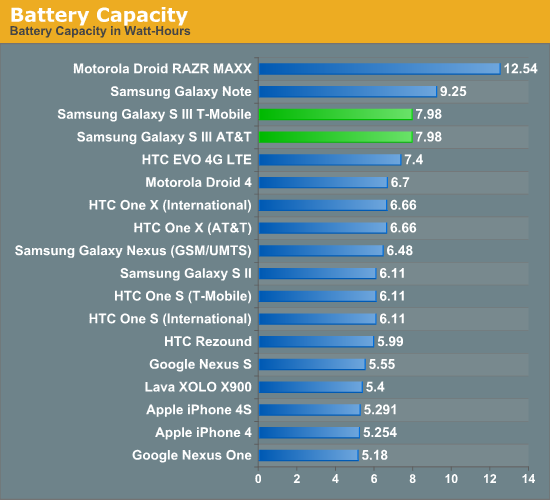
I spent a big part of my limited time with the SGS3s battery life testing, and turned to our Smartphone 2011 suite of battery life tests which I’ve described in detail before. The web browsing tests consist of a few dozen pages which are loaded every 10 seconds with the display set at precisely 200 nits (using a meter) until the phone dies - this is done over WiFi and cellular data. The tethering test consists of a single client notebook attached to the device using its onboard WiFi hotspot function, and four tabs of our page load test alongside a 128 kbps streaming MP3 station are loaded on that notebook until the phone dies.
I was supplied the AT&T and T-Mobile SGS3s, which differ in air interface and band support. The T-Mobile version is on the carrier’s DC-HSPA+ network for testing, and the AT&T version supports both HSPA+ (single carrier) and LTE. Unfortunately AT&T LTE is not lit up in my Tucson, AZ market yet (which would make my life so much easier), so I could only run the 3G WCDMA result. 4G LTE results from that particular device will come shortly and I’ll update appropriately.
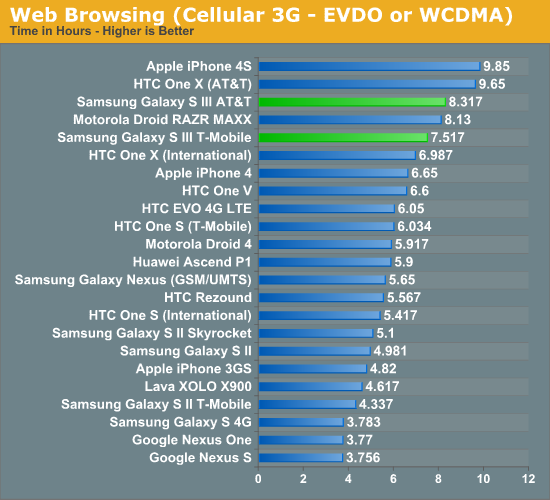
Immediately we can see that the combination of MSM8960 and Samsung’s big battery really pay off for the SGS3. Both the T-Mobile and AT&T versions (on DC-HSPA+ 42.2 and HSPA+ 14.4, respectively) post impressive numbers around 8 hours. This is with the display set at 200 nits in the browser, which is one tick short of all the way to maximum on the SGS3. Samsung has included a ton of battery saving display analysis features in the SGS3 browser, which were turned off for this test. Obviously if you turn those on (I would) you’ll be able to push battery life even further. It is shocking how close we come to the previously untouchable iPhone 4S.
As soon as I get the AT&T LTE numbers (I have to travel to an AT&T LTE market and carry out the test there) I’ll update with that graph here.
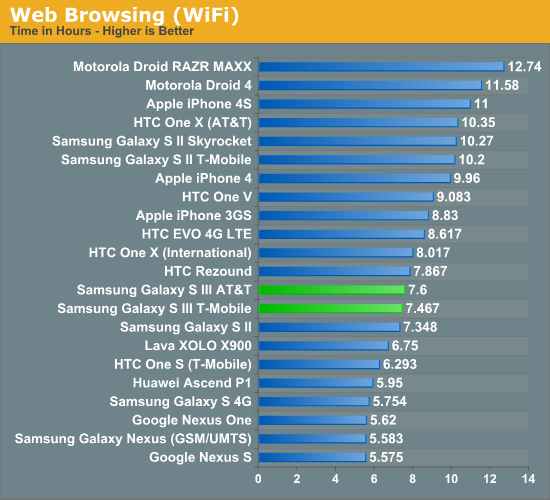
Next up is the WiFi battery life test, which posts numbers right around where the 3G cellular test was. You might be wondering why this is since the SGS3 includes an even lower power WiFi stack (BCM4334 even in the Krait-based USA variants). The result indicates to me that we’re almost entirely dominated by display power draw here. If we ran with a lower brightness, I expect you’d see WiFi longevity pull in front of cellular like you’d expect.
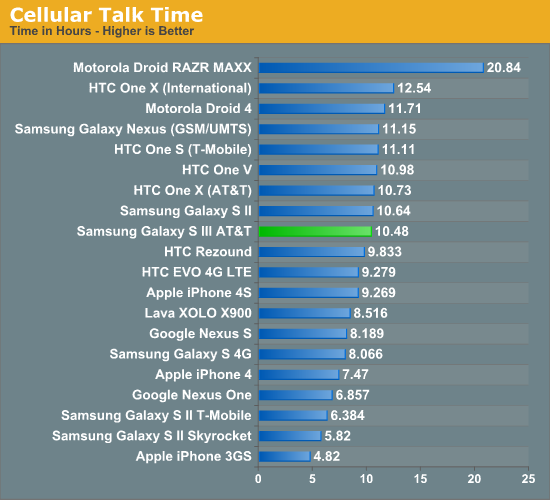
Cellular talk time is starting to get so long that it’s hard to test - I essentially lost an entire day of playing with the AT&T SGS3 to running a call time battery life test. This is a good problem to have, though I’m surprised it didn’t go just a bit longer and match or beat the One X AT&T result.
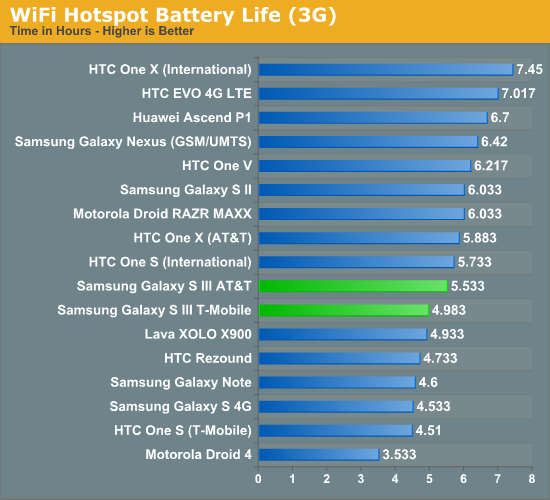
The 3G hotspot test really tells what things are like with the display turned off. Quite honestly I’m surprised the SGS3 doesn’t do much better here – it’s possible there’s room for further optimization of the WiFi hotspot mode on SGS3. Likewise, I’ll update with 4G LTE numbers for the AT&T model as soon as I’m in an area where it’s lit up and I can burn a few hours testing.
Overall, in my time with the SGS3 I would subjectively describe battery life as above average. With AMOLED, 200 nits is actually pretty bright, and you see Samsung and other OEMs clamping display brightness well below the physical limits to both save power and prevent burn-in.
Obviously the other interesting question is how the SGS3 fares on its battery saving mode with the CPU clock capped at 1.0 GHz. That’s also next in line for testing.










107 Comments
View All Comments
HexiumVII - Wednesday, June 20, 2012 - link
Darn no quad core love for the US?Impulses - Wednesday, June 20, 2012 - link
No big loss, the S4 is roughly equivalent despite being a dual, since it's an all new design instead of a core bump. The GPU is actually the bigger loss, if you're into graphically intensive games.B3an - Wednesday, June 20, 2012 - link
Exactly.The international quad-core version (which i have and love!) is based on ARM Cortex A9. While the US dual-core version uses the Krait SoC which is a lot closer to ARM's new Cortex A15 design (but it's not an A15, it's a custom design from Qualcomm thats similar in performance). So overall for CPU performance the international and US versions are pretty similar.
The international version definitely has a better GPU though - the higher clocked Mali-400 is the fastest GPU in any phone at the moment. Where as the US version has the slower Adreno 225.
On the other hand... the US version has 2GB RAM, where as the international has 1GB.
I guess Samsung felt bad about the slower GPU and tried to make up for it by giving you all 2GB instead.
Personally i prefer the international version because of the extra GPU performance as i do more gaming, and with a screen this big @ 720p gaming is great.
robinthakur - Friday, June 22, 2012 - link
So...quick question. I have an international version which I picked up in HK as well. What games actually make good use of the improved graphics? I've already got Angry Birds Space. I'm not that impressed with the device so far. The thin plastic back feels incredibly cheap for a device costing around £400 and the Android OS seems poorly optimised compared to the iPhone 4S I used to use, with much worse touch controls. The camera which initially sold me (along with the nice water drops animations on the Home screen!) with its rapid shots, also disappoints with pretty mediocre pictures compared to the 4S. Front facing camera is nicer though. The motion controls are utterly pointless as is face unlocking. Have you ever got the wave hand across the screen to take a screenshot to work? I've got it switched on but...nothing! There were plenty of options compared to iOS for to geek out over for 48 hours but now having to actually use the device it seems lacking, i dunno, just unpolished. Considering it just came out, why is text all fuzzy for example? Isn't this a retina display? I assumed that coming out more than 2 years after the iPhone 4, every phone has them these days, but apparently not. I'm considering selling it before the price drops and going back into the Apple Matrix as life seems easier with iOS all told.JamesL88 - Saturday, June 23, 2012 - link
"What games actually make good use of the improved graphics?"Well for starters newest Gameloft games such as the NOVA 3 tend to be very graphically demanding. Also True Android gamers love to buy emulators from black markets (or after markets if you prefer), such as Nintendo 64 emulator.
You're obviously iFan so I'm not going into discussion with strength and weaknesses of each OS, but I believe the GS3 uses the same Sony sensor used in iPhone 4s' camera. I seriously doubt that you even own GS3.
koyanishi - Tuesday, September 4, 2012 - link
I believe he does own a Galaxy S III.that's because he didn't figure out how to take the screen shot by swiping his hand across the screen.
The thing is, to do this your hand has to touch the screen. Your hand is in the form of a karate chop and you use the knife edge (sort to speak) to touch the screen and swipe across it.
I don't think he is that stupid for missing this because I after trying different ways of doing it never figured it out either but only learned of how to do it by reading tips on use of this phone in an android forum.
However on his other points of how the plastic feels cheap and lack of optimization (whatever that means) of the os in GS III I disagree.
bigboxes - Wednesday, June 20, 2012 - link
Am I wrong? The device doesn't look like it can stand up to much of anything. Better make sure you cover it from top to bottom with some kind of case.ATWindsor - Wednesday, June 20, 2012 - link
You probably are, plastics can be very solid and lightweight. The old Galaxy S2 is as far as one can tell much more solid than for instance the iphone.Impulses - Wednesday, June 20, 2012 - link
Samsung's designs may feel cheap at times but that doesn't necessarily translate to better impact survivability... Plastic weighs less and probably absorbs more force during impact... I've never owned a Samsung phone (I'm on my third EVO and my dumb phones were all Nokias & Sony) but I've seen plenty of them fly from my friend's hands. :p The glossy plastic they use probably does scuff easier than most materials tho. Then again, unlike reviewers who go thru phones like underwear, I think the majority of people end up it using cases anyway. I do it to protect my device's resale value as much a anything else.Belard - Wednesday, June 20, 2012 - link
What resale value?